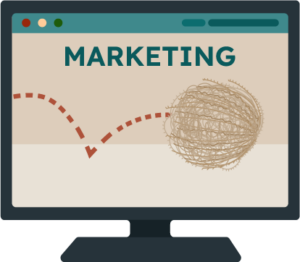We have a lot of ground to cover today as we plan to provide solutions to your burning problems, so let’s get right into it: we talked to a critical mass of healthcare providers, determined to uncover the most common challenges you face in marketing your healthcare business.
In these conversations, four challenges stood out as a constant to many practices, and we’ll be addressing and detangling them for you, right now!
Ok, right after this author says to their mom: yes, I absolutely do have an answer to everything.
Ok, right now.
 Patient Acquisition Challenge #1: Standing Out Among Competition
Patient Acquisition Challenge #1: Standing Out Among Competition
Though medical professionals stand united in their mission to improve and save lives, they find themselves in competition when it comes to attracting patients.
As the competition intensifies, standing out and reaching new patients is a significant patient acquisition challenge, especially as more and more people rely on the digital world when making healthcare decisions. To rise above competitors, the first steps of your strategy should be a strong online presence and reputation.
Build A Strong Online Presence
Building a strong online presence comes with greater visibility and higher awareness of your practice.
As most people begin their healthcare journey with online searches, you must optimize your website and listings for search engines through SEO to ensure you rank high in relevant searches. Optimizing your website and writing relevant content will help you reach patients at the beginning of their journey when they start looking up symptoms or exploring solutions for specific healthcare problems.
On the other hand, optimizing your local listings, such as Google Business Profile and Apple Business Connect, will help you rank for local searches, such as “dentist near me”, allowing you to reach patients in the later stages of their journey.
Additionally, investing in paid search will help you reach specific audience groups and provide more visibility on the limited screen space.
Going beyond search, it’s worth exploring improved social media strategies that offer more potential for virality and audience engagement.
Establish A Stellar Online Reputation
Building a credible online reputation is crucial for gaining the trust and confidence of potential patients. Since “these modern kids are always on their phones” (and we’re all children at heart), your online reputation often serves as the first impression for people seeking healthcare services.
Actively managing your presence on popular review platforms, of which Google Business Profile, Yelp, and Healthgrades are a must, will get you far in word-of-mouth marketing.
And while reviews help build credibility and demonstrate your quality of care, it can be hard to get them on a regular basis, and even harder to respond to them all in a timely manner.
A casual reminder on the front desk can easily slip patients’ minds, so to truly capitalize on your online reputation in overcoming the challenge of competition, the best approach is to automate review requests using healthcare marketing technology. To further streamline reputation management, look for a tool that offers centralized management of multiple listings, making sure you never miss addressing important patient feedback.
To ensure you remain on top of your online brand, monitor popular social media platforms for online mentions, reshare positive experiences, and address any concerns swiftly to maintain your practice’s reputation as a trusted healthcare provider.
Patient Acquisition Challenge #2: Lack of Marketing Resources
 Many healthcare businesses, especially smaller ones, struggle with limited marketing budgets and resources. To make matters even worse, during the economic downturn, the marketing budget is usually the first to take the hit.
Many healthcare businesses, especially smaller ones, struggle with limited marketing budgets and resources. To make matters even worse, during the economic downturn, the marketing budget is usually the first to take the hit.
This lack of resources can make it difficult to compete with larger organizations that have more patient acquisition dollars at their disposal. But don’t lose hope: with strategic planning and the right approach, you can effectively reach your target audience even on a modest budget.
Leverage Organic Campaigns
When resources are tight, organic marketing campaigns can be a lifesaver (and we do feel the need to add: figuratively). By focusing on organic growth through content marketing, SEO, and social media engagement, you can build a strong online presence without the need for significant financial investment.
Creating valuable, informative content that speaks to the concerns of your potential patients will ensure they find you when they need you. Engaging with your audience on social media and partnering with local businesses and influencers to promote important health causes can further amplify your reach, allowing you to connect with potential patients in a meaningful way.
Organic campaigns may take time to yield results, but they offer sustainable growth and build trust with your audience over the long term.
Invest in High ROI Campaigns
Look, if you have a little bit of money, invest it in campaigns that yield high ROI. We’re always taught not to put all our eggs in one basket, but stretching already small budgets across multiple channels and strategies will often only water them down even more.
Predictive targeting is an excellent strategy for maximizing healthcare marketing ROI, as it uses data analytics and machine learning to identify high-value cases for patients in need of your services. Targeting at-risk patients for different service lines allows for a higher level of campaign personalization, boosting your chances of sparking their interest. By focusing your marketing efforts on potential patients who are most likely to convert, you can reduce wasteful spending and achieve better results with less.
Predictive targeting in healthcare significantly improves patient acquisition and ensures that every dollar spent is driving meaningful outcomes for your practice. To drive this point home, let us just say: healthcare businesses using predictive targeting have seen up to 2,500% ROI.
 Patient Acquisition Challenge #3: Limited Staffing Resources
Patient Acquisition Challenge #3: Limited Staffing Resources
In addition to tight budgets, many healthcare businesses face the challenge of limited staffing resources, making it difficult to manage both patient care and marketing efforts effectively.
With a small team or staff stretched thin, maintaining consistent marketing activities can be overwhelming, especially when trying to keep up with the demands of ongoing patient acquisition and retention.
While winging it (we know you’ve tried it!) isn’t a great approach, marketing automation offers a powerful solution to this patient acquisition challenge, enabling practices to streamline their marketing efforts without overburdening their staff.
Embrace Marketing Automation
Marketing automation allows healthcare practices to automate repetitive tasks such as appointment reminders, review requests, data analysis, patient satisfaction surveys, email campaigns, and social media posting.
By automating these processes, your practice can maintain a consistent online presence, boost online ratings, and nurture patient relationships without requiring constant manual input from your team. This frees up your staff to focus their limited time on strategy and ensures that your marketing efforts remain consistent and effective.
Moving beyond task management, automation tools can provide valuable insights and analytics, helping you track the performance of your campaigns and make data-driven decisions, ensuring your practice continues to reach and engage with potential patients while maximizing efficiency.
By leveraging marketing automation, you can overcome the challenge of limited staffing resources, make the most out of your marketing, and continue to grow your patient base without straining your team.
Patient Acquisition Challenge #4: Measuring ROI and Marketing Reporting
 Another headache-inducing patient acquisition challenge healthcare providers have reported facing is accurately measuring ROI and effectively reporting on marketing performance. With HIPAA regulations placing strict limitations on data usage in the healthcare industry, many healthcare marketers find themselves relying on vanity metrics, like clicks and impressions, to demonstrate their performance.
Another headache-inducing patient acquisition challenge healthcare providers have reported facing is accurately measuring ROI and effectively reporting on marketing performance. With HIPAA regulations placing strict limitations on data usage in the healthcare industry, many healthcare marketers find themselves relying on vanity metrics, like clicks and impressions, to demonstrate their performance.
While these metrics can be helpful indicators, they don’t offer a complete picture of how marketing drives patient acquisition, retention, or overall business growth, leaving healthcare providers or decision-makers hesitant to consider marketing a lucrative investment.
Use HIPAA-Compliant Marketing Analytics Tools
To truly understand what works and what doesn’t, you need to go beyond website clicks and focus on meaningful KPIs that reflect actual business outcomes. The most important metrics to track include Patient Acquisition Cost (PAC), Patient Lifetime Value (LTV), Return on Ad Spend (ROAS), and conversion rates.
This is where healthcare marketing analytics tools come into play. These platforms are designed to help healthcare businesses track and analyze their marketing performance while ensuring full HIPAA compliance.
By integrating with your practice management and EHR systems, these tools provide a comprehensive view of your marketing performance, allowing you to see exactly how many new patients were acquired through specific campaigns, which service lines are driving the most revenue, and where to allocate future marketing budgets for the highest ROI.
Compliant and complete marketing analytics tools also help streamline the reporting process. They often provide real-time data and easily manageable dashboards that let you easily track your main KPIs and make data-driven decisions.
While mainstream marketing analytics tools often fail to consider healthcare-related challenges, embracing healthcare-specific tools still allows you to understand what works, ensuring every dollar spent contributes to sustainable business growth and improved patient outcomes.
Find The Right Set of Healthcare Marketing Tools
Overcoming patient acquisition challenges in healthcare is no small feat, but identifying the highest-stake challenges is the first step toward creating targeted solutions. Our research helped us understand where healthcare providers struggle the most—whether it’s standing out in a crowded market, managing limited resources, dealing with understaffed teams, or measuring ROI—so we can develop strategies that directly address these issues (the benefits of data-informed approach at work!).
Now, to successfully apply the strategies we explored in this article, you’ll need a trusted high-tech ally!
Fortunately, SocialClimb’s comprehensive healthcare marketing platform is designed to tackle these exact challenges. With centralized reputation management that covers multiple listings, automated review requests, and compliant review response templates, you can build and maintain a stellar online presence effortlessly. Our healthcare-focused search ads tools and one of the few HIPAA-compliant predictive targeting solutions on the market help ensure your marketing dollars are spent wisely, targeting the right patients at the right time. Finally, SocialClimb’s robust analytics tools let you track key performance indicators and streamline reporting, giving you the insights you need to optimize your marketing strategy and drive meaningful outcomes.
Investing in comprehensive healthcare marketing software will help you overcome the patient acquisition challenges and build a scalable healthcare business, knowing you have the right tools to support your growth every step of the way.
See, we told you we have the answer to everything.











